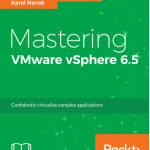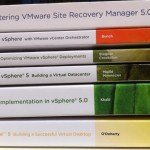Mastering VMware vSphere Storage book is intented for users who already have some experience with the VMware vSphere platform and want to learn and design VMware vSphere storage solutions and how to troubleshoot vSphere storage issues.
The main purpose of this book is monitor and optimize the storage capabilities of your vSphere environment.
 This book is structured in the following chapters:
This book is structured in the following chapters:
- Chapter 1, Getting Started with vSphere 5.x and vCenter 5.x, shows you the difference between physical and virtual hosts and the benefits of using a virtualized host, and describes how to set up VMware ESXi Server and VMware vCenter Server.
- Chapter 2, Getting Started with vSphere Management Assistant, explains what VMware vSphere Management Assistant is, how to set up and configure it with vSphere Server, and how to enable ESXi TSM during troubleshooting.
- Chapter 3, Using the Virtual Machine Monitor, introduces the components of the VMware vSphere ESXi architecture and the VMM. You will also learn the techniques to configure software and hardware with VMM in the virtual machine.
- Chapter 4, Storage Scalability, explains the vSphere Storage API for Array Integration (VAAI) and Storage Awareness (VASA). In this chapter, you also learn about the vSphere administrator and how to configure the virtual machine storage profile and assign it to the ESXi data store.
- Chapter 5, Optimizing Storage, teaches you the concept of storage virtualization and how to monitor the storage metric using vSphere performance charts and esxtop/resxtop. You will also learn about the management of vSphere storage using the command line.
- Chapter 6, vSphere Storage Configuration Settings, discusses what a storage component is, for example, the LUN name, identifier name, and runtime name. You also learn how to set up LUN masking on a vSphere host using esxcli commands, and setting up vSphere Syslog Collector to collect the ESXi host’s log.
- Chapter 7, Analyzing vSphere Storage by CLI, provides more commands for managing vSphere storage. Here, you also read about the difference between the existing VMFS signature and resignaturing.
- Chapter 8, Troubleshooting vSphere FC Storage, focuses on troubleshooting vSphere FC storage, and explains the FC storage infrastructure. This chapter lists some examples that show you how to troubleshoot.
- Chapter 9, Troubleshooting vSphere iSCSI Storage, is concerned with analyzing the vSphere iSCSI storage infrastructure, and lists some examples that show how to troubleshoot.
- Chapter 10, Troubleshooting vSphere NFS Storage, describes some examples that tell you how to carry out NFS troubleshooting.
- Chapter 11, vSphere Storage Design, tells the story of the vSphere storage architecture design and its main point. This chapter also illustrates the design method.
- Chapter 12, ESXi Host Design, contains the story of the key points of the ESXi host design, according to the actual environment, for example, how to design the host.
- Chapter 13, Virtual Machine Design, analyzes the main points of the virtual machine design in detail. At the same time, according to the actual environment, we see, for example, how to design the virtual machine.
- Chapter 14, vSphere Virtual Datacenter Design, describes in detail the main points of the virtual data center design, and as an example, we see how to design a virtual data center.
In my opinion chapter 1 with all the installation steps of vSphere components is completely useless (it’s a mastering book, not a beginner book) and should be replaced by an architectural overview on how is implemented the storage part of VMware vSphere.
Also chapter 2 on how deploy and configure vMA could be removed (or moved to an appendix), because it’s not relevant with the main book topic (can be useful for troubleshooting, but it’s not the only tool). The only really interesting part is how manage logs, but this should be part of the troubleshooting chapter.
Chapter 3 is interesting for understanding how VM resources are used, but again not strictly relevant with the storage part.
Finally the rest of the book is related to the vSphere storage topics, but the order (in my opinion) is not so logical, starting from VAAI and VASA, instead of the different storage layers and different datastore types.
Chapter 12 and 13 are again out of topic (except some part of chapter 13 on how design the virtual storage of a VM, but need to be improvements).
So a great objective, but a not focused executions… if the topic is the storage, this topic must be followed and explained deeply… design host CPU can be relevant if you are talking about storage overhead (like in software iSCSI).
Also storage architectures like converged or hyper-converged systems aren’t considered at all (it’s a shame) and all the book is outdated to version 5.x of vSphere (neither updated to 5.5U1 because Virtual SAN is just mentioned in a few sentences). Same for flash and caching solution that are completely ignored.
Remain useful for the troubleshooting part that cover FC, iSCSI and NFS cases, but could be improved with more examples and some baseline data and parameters to help diagnostic and comparisons.



